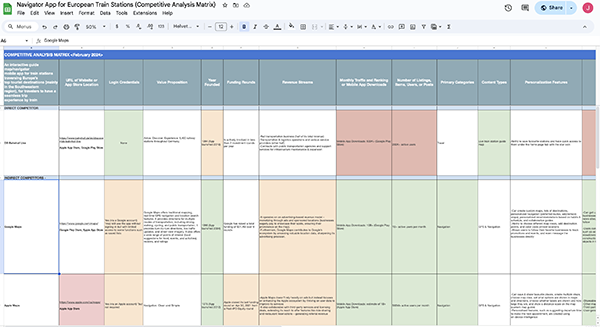Train Station Navigation App: UX Design Process (2024)
UX Design | Provisional Persona | Competitive Research & Analysis | User Workflows | Content Hierarchy Diagram
Contents
- Introduction
- Vision Statement
- Provisional Persona
- Research
- Interview
- Creating Customer Profile
- Priority Chart
- Analysis
- Competitive Research & Analysis
- Competitive Matrix
- Findings Brief
- Concept Development
- Value Proposition Map
- User Workflows
- Content Objects
- Content Hierarchy Diagram
- Evaluation
- Card Sorting Result
- Reflection

During my Strategic Design for Business class (GDES 208) at BCIT, certain User Interface (UI) and User Experience (UX) principles, concepts, and techniques were taught and applied to create a comprehensive campaign project for a digital application or website of our own choosing. I came up with an idea of developing a train station navigation app for major cities and locations in Southwestern Europe, where most travelers and tourists go to, in order to facilitate ease, convenience and peace of mind while traveling, as well as eliminating language barriers especially for foreign travelers.
This particular artifact page focuses on the UX design portion of the app development whereas a separate page is dedicated for the UI portion here.
Project role:
UI/UX Designer (Individual class project)
- Created all project deliverables: came up with the mobile app idea, including defining its vision statement and persona; conducted research, interview, and analysis; developed concepts for a proposition map, user workflows, content objects, and hierarchy diagram; conducted a card sorting survey to evaluate design iteration
Program used:
Figma
Key skills demonstrated:
UI/UX design | Strategic Design for Business | Research and Analytical thinking | Usability Testing
Introduction
Goal-setting and delineating a clear vision statement are crucial to achieve success in any endeavour, in this case for a strategically-designed business in the form of a digital service/product. To formulate a vision statement, certain questions have to be answered such as the following: 1) Who is your target group? What's the concern you'd like to address?; 2) What would you like to offer? Why would they buy it?; and, 3) Where are you going with your proposition? What's your short/mid/long-term goal?
The next section delves on the answers from the above questions to make a clearly-defined vision statement, specifically for the train station navigation mobile app business proposition.
Vision
To provide an interactive guide map/navigator mobile app for train stations traversing Europe’s top tourist destinations (mainly in the Southwestern region), for travelers to have a seamless trip experience by train, addressing the worries of getting lost or ever missing a train ride, due to navigation issues and/or language barriers.
The short term goal is to have at least 100K app downloads on its first year of launching, and then to have 500K+ app downloads with 200K+ active users as the midterm goal in 5 years. Finally, the long-term goal is to expand to the rest of Europe with a possibility of reaching other continents, as well. Future service expansion also includes the ability to provide navigation services for other transportation hubs such as airports, metro and bus terminals.
Persona
Description
• Late 20s/Early 30s
• A digital nomad from Ontario, Canada
• Educated
• Freelance remote work (i.e., photography, blogging, etc.)
• Makes a decent living from various streams of income
Behaviour
• Inclined to operate in a timely fashion
• Prefers taking public transit, such as trains, metro, trams & buses, and other forms of sustainable transportation
• Tech-savvy with a strong social media presence & following
• Values information from reputable and valid sources
• Applies efficient methods to save time, resources, and energy, such as utilizing productivity apps and useful gadgets to make working while traveling as smooth as possible
• Constantly updates oneself with new tech trends
Needs & Goals
• Dreams of being able to capture as much wonderful sights as possible via photography, while traveling the rest of the world including Europe
• Can’t afford to have time wasted as she makes the most out of every place she goes to—catching beautiful sunsets, wildlife, & natural phenomena, and seeing notable art & architecture
• Wants every trip to be planned accordingly; makes travel plans & bookings well ahead of time
• Financially-cautious; loves scoring good deals to get the best bang for the buck
• Needs relevant information to be able to navigate around foreign places, and is also eager to learn new languages
• Aims to travel sustainably by reducing carbon footprint
Research
previous | back to top | next
Interview Conduct
Interview Result
Customer Profile
Priority Chart
Concept Development
previous | back to top | next
Value Proposition Map
User Workflows
Content Objects
Combined User Workflows and Content Objects
Content Hierarchy Diagram
Reflection

One might think graphic designers are just all about putting together visual elements to make a final composition work and to be ready for use out in the real world. Little do we know that a lot of brainstorming, researching, and analyzing go into every single project, especially when developing digital services or products such as websites and mobile applications. This graphic design course project, in particular, allowed me to experience what goes on behind the development of digital products by adapting UI/UX design strategies.
Inspired by a recent travel to Europe, including some mishaps encountered while traveling by train, I immediately thought of a train station navigation app idea for this course project. And during my research conduct I would later on find out that a number of other tourists, who also experienced traveling by train in Europe, to have had the same worries and troubles navigating train stations. Thus, I felt confident that my app concept would be a viable business idea when it is backed up by quantitative research to justify its development.
Furthermore, the importance of a systematic evaluation of user experience per iteration cannot be more emphasized as such would be the defining factor for consumers to effectively utilize a digital product and for them to want to keep it. Securing a seamless user experience is vital in order to meet the established project goals.


